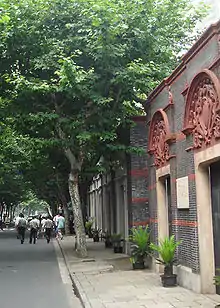Xintiandi
Xintiandi (Chinese: 新天地; pinyin: Xīntiāndì, Shanghainese: Shintidi lit. "New Heaven and Earth",[1] fig. "New World") is an affluent car-free shopping, eating and entertainment district of Shanghai designed by global architecture firm Skidmore, Owings & Merrill.[2][3] Xintiandi now refers to the wider area centered around Madang Road which includes both pedestrian-only and motor traffic roads.


Overview
The district is composed of an area of reconstituted traditional mid-19th century shikumen ("stone gate") houses on narrow alleys, some adjoining houses which now serve as book stores, cafes and restaurants, and shopping malls. Most of the cafes and restaurants feature both indoor and outdoor seating. Xintiandi has an active nightlife on weekdays as well as weekends, though romantic settings are more common than loud music and dance places. It is considered one of the first lifestyle centers in China. It is also the most expensive place to live in China, with some apartments costing more than Tokyo, New York and London. It is home to the Chinese elite and top executive expats.
Xintiandi is the location of the site of the first congress of the Communist Party of China, now preserved at the Museum of the First National Congress of the Chinese Communist Party. Also nearby are the Shikumen Open House Museum and the site of the Provisional Government of the Republic of Korea when Korea was a Japanese colony.

Redevelopment
The area was developed by Shui On Land during the re-development of the surrounding area. Some houses in Xintiandi were then renovated in order to implant an art gallery, cafes, and restaurants. Many tour groups both domestic and from abroad also visit Xintiandi as one of the main attractions in Shanghai.
The Xintiandi redevelopment was designed by Skidmore, Owings & Merrill,[4] in collaboration with Benjamin T. Wood and Nikken Sekkei International. The urban renewal is considered one of the first examples of the placemaking approach in China.[5])
This construction displaced 3,500 Shanghainese families.[6]
Transportation
The closest Shanghai Metro stations in the vicinity are South Huangpi Road Station (on Line 1), Xintiandi Station (on Line 10 and Line 13) and Madang Road Station (on Line 9 and Line 13).
See also
References
- Warr, Anne: Shanghai Architecture, The Watermark Press, 2007, ISBN 978-0-949284-76-1
- https://www.sfgate.com/business/article/S-F-architects-helping-to-reshape-Shanghai-2676907.php
- Pitts, Christopher (April 2013). "Top Sights: Xintiandi". Pocket Shanghai (3rd ed.). Lonely Planet. pp. 60–61. ISBN 978-1-74179-963-7.
- https://www.sfgate.com/business/article/S-F-architects-helping-to-reshape-Shanghai-2676907.php
- Our Man in Shanghai: Ben Wood Takes On History
- Xintiandi
External links
| Wikimedia Commons has media related to Xintiandi. |

